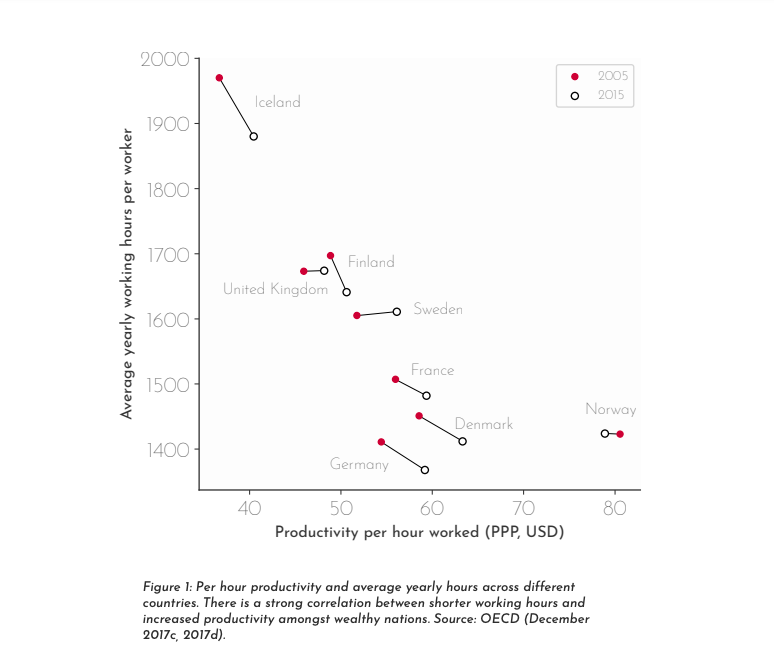Why 4-day workweek might be not as successful as it seems

The idea of a four-day workweek has evolved from a vague concept to a pragmatic consideration. Some companies have tested it with apparent success. But before you go and run experiments on your turf, take a look at the data and avoid disappointment.
“Four-day week has been an overwhelming success in Iceland,” proclaimed international headlines recently. The research showed that cutting the standard workweek down to four days for the same pay did not bring productivity down. Instead, productivity increased in most of the workplaces studied. Workers in Iceland reported being less stressed and admitted that their work-life balance had improved.
It sounded almost too good to be true. When we look closely at the data, we realize that the proclaimed success is not the whole story. And that a four-day workweek can prove to be both a success and a failure.
Hard data on the Icelandic experiment
Let us first look at the details of the Icelandic experiment. The trials took place between 2015 and 2019 and included 2,500 workers, which amounts to about 1% of Iceland’s working population.
But the trials did not assume a four-day week, contrary to what the media headlines said. Instead, they reduced weekly hours from 40 to 35 or 36, depending on the job. It means that the employees worked an hour less every weekday – not that they worked only four days a week.
The participants were mainly public sector employees and civil servants. They were mainly working in child protection services, nursing and home care, the police, schools, and museums.
The results, published in a comprehensive report, show that indeed there was no loss of productivity. Instead, employees reported having a better work-life balance, more time for themselves, more exercise, less stress at home, and improved social well-being.

People analytics to determine the target
The Icelandic experiment showed some positive effects of reducing working hours. Still, there were managers who felt that the pace of work had increased and that educational and training days were more complex to set up. One should also remember that the trial concerned a particular group of people (public service sector workers). What’s more, the focus was not on productivity but more on people’s well-being.
Therefore, these results do not necessarily translate to other countries, industries, or your company.
“Before considering any change in working hours in your organization, determine the problem you want to solve, the goal you want to achieve, and back up your decision with data from people analytics,” says Daniel Aduszkiewicz, the CEO and Co-Founder of Human Panel.
Aduszkiewicz advises answering the following questions: Do you have a productivity problem across the organization or just in a specific team? If so, what are the blockers that are preventing the team from reaching its full potential? Is it leadership, lack of tools, or inadequate planning?
Going into detail can be more effective than implementing a company-wide policy.
Daniel Aduszkiewicz
Kickstarter tests four-day workweek
In June, the crowd-funding platform Kickstarter announced a pilot of a four-day workweek to begin in 2022. Several other trials are underway around the world. Unilever is giving employees in New Zealand the option to reduce their working hours by 20% without affecting their pay. A shorter working week is also being tested in Spain.
Although these trends were gaining popularity before the pandemic, they seem even more enticing today. One of the reasons for this could be that companies need to implement measures that will help them attract and retain talent. A four-day workweek seems to be a great advantage in terms of company PR and employer branding. But does it boost productivity?
“When you experiment with shortening the workweek, you can succeed or fail. And either way, the reasons can vary and depend on the time, the team, and the scale. You can cut 20% of the time off and see if productivity increases, decreases, or stays at the same level. But be careful with the choice of team and time for the experiment, as this can skew the results and ultimately influence your decisions,” says Daniel Aduszkiewicz.

The Hawthorne Effect
There are success stories about shortening work hours. Microsoft Japan saw a 40-percent increase in productivity after testing a four-day workweek in 2019. Swedish nurseswho worked shorter hours for 18 months in 2016-2017 logged less sick leave and organized 85% more activities for their patients.
But some researchers, for example Professor Anthony Veal from the University Technology Sydney Business School, notes that the “Hawthorne effect” could influence the results. He refers to experiments with factory workers in the US who modified their behavior in response to their awareness of being watched.
“Of course, one might expect that workers would be happy to work reduced hours, but would they also repeat the work practices required to maintain productivity levels? All of this calls for further research,” he wrote in a paper for the academic journal Conversation.
Data-driven decisions
Reducing working hours can be successful. But before you decide to follow in someone else’s footsteps, analyze the data about your workforce and determine the goal you want to achieve. Depending on whether it’s attracting talent, increasing productivity, or improving the well-being of your employees, you may want to act differently.
“Experimenting on your team can be tricky, especially if you operate at a large scale. So I suggest that you gather adequate data before introducing any new policy to make an informed decision,” Daniel Aduszkiewicz concludes.
If you want to work with the right data and the right tool that will make your workforce management easier, check out our free demo and see how Human Panel can help you solve your problems. Contact us by filling in the form below.



